Sailing bullet
“And the bullet is ... all the same, full of holes !!!”, again mossy orthodoxes from artillery will say if they read this, the second, article from the cycle “Weapon from the pass.
And again they will be right, really the bullet as it was, and remained full of holes.
But this is again not on purpose, since the unshakable laws of physics were ordered.

«And the bullet is ... full of holes !!!”, Was the name of the first article on the topic of aerodynamic acceleration of bullets up to speeds of 5-10 km / sec. It proposed and justified the method of aerodynamic acceleration of a bullet (projectile) in the barrel. So that no one had any doubts, a standard lead bullet and a primitive mock-up of a sailing bullet, which was a scrap of a self-tapping screw with a diameter of 4.5mm, was shot from a conventional air rifle. The shooting was carried out on an aluminum sheet 12 thick millimeters, the usual bullet could not penetrate it naturally, but the “holey” and very “clumsy” sailing bullet easily pierced it.
The results of the shooting were filmed and posted in the article, but apparently the photo turned out not very convincing, so this video will be posted a video of the real shooting.
For greater effect and clarity, the rifle was upgraded for shooting with sailing bullets. As they say, feel the difference ...
American recruit turns into a Russian conscript

This American "recruit" company "Krosman" will be forcibly turned into a Russian draftee.
Not even a draftee, yet only in a conscript.
The American "recruit" with a slight movement of the arm with a grinder and "some kind of mother" turned into a Russian "recruit" optimized for shooting with sailing bullets. The upgraded rifle did not lose power and when firing conventional bullets (on the contrary, it began to shoot harder). Alteration of the rifle was required because of the significantly greater gas consumption when fired by a sailing bullet. In a traditional shot, all gases are locked in the barrel by a moving bullet, respectively, during aerodynamic acceleration, some gases pass between the walls of the barrel and the body of the bullet through the sailing surfaces of the bullet and a larger gas charge is spent on one shot.
But the gas does not go away in vain, this gas transfers the kinetic energy of its movement to the sailing surfaces of the bullet and additionally accelerates it. Actually the increased efficiency of the aerodynamic bullet is due precisely to the energy of this additional flowing gas stream.
In the case of firing conventional bullets, the additional gas charge also works, but not efficiently enough, and part of it is simply lost.
In addition to increasing the volume of the gas charge, a transition was made from compressed air to carbon dioxide. There is also a small trick related to the physics of the process of dispersing a bullet. For an ordinary bullet, the density (more simply, the weight of a gas molecule) of a gas charge does not matter that it is hydrogen, that it doesn’t care for air, as long as the pressure is the same at its bottom.
But for a sailing bullet, gas density is of fundamental importance. Since kinetic energy is exchanged between the bullet and the gas jet on the sailing surfaces, the higher the gas density, the more efficiently the gas jet transfers energy to the sailing surfaces of the bullet. And that is why the “recruit” was transferred to carbon dioxide, it is one and a half times heavier than air at the same pressure.
How to shoot
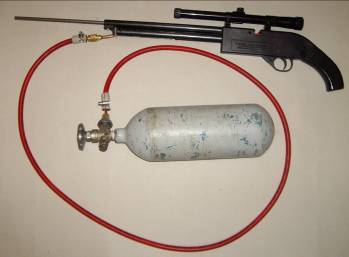
Such a “shaved” Russian conscript turned out
In addition to the necessary improvements of the American "recruit", my sense of beauty required me to remove everything unnecessary from him.
Left bare functionality, nothing superfluous.
All that was not needed for firing, and only made it heavier and cluttered the product was ruthlessly cut off.
For convenience of experiments, the gas was poured into a two-liter bottle and connected to the rifle with a flexible high-pressure hose. The reducer was not used and the pressure in the cylinder (slightly less than 60 atmospheres at room temperature) is directly flowed into the barrel bore when fired (with the battery capacity of 5 cubes in front of the combat valve naturally).
So, despite the exotic look, we can say that this is a regular gas rifle, the type of those that work on 12g. cartridges with carbon dioxide. It is certainly not as powerful as rifles in atmospheric air compressed to 300, but the bullet flies out of it as well, if not better. There was an idea to heighten the effect, too, to switch to pressure in 300 atmospheres, but after sorting out the "recruit" and finding inside the plastic stuffing, I refused this idea. I still need my fingers and eyes ...
What we shoot
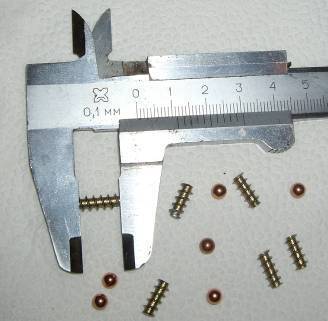
The transition to carbon dioxide allowed to increase the power of the shot. For the disposal of this power, the sailing bullet itself was refined, it became corny longer.
And we will compare the sailing bullet in terms of the power of the shot with the fastest and most powerful bullet for pneumatics, the standard steel copper-coated ball.
If the sailing bullet needed three rifled sails on compressed air, then carbon dioxide required five rifling holes and its length was about 11 millimeters. We will compare it with the standard and most powerful bullet for pneumatics, the standard steel ball, on these bullets because of the lack of friction on the rifles, the power of the shot in pneumatics increases by 10, due to the accuracy of course.
But about accuracy while we are not talking, this is the topic of another article, and our primitive, unbalanced bullet from trimming screws will not allow you to shoot for sure, God forbid that you would not tumble in flight and especially when confronted with a target.
So, only the power of the shot will be compared, and we will evaluate it according to the traditional technique of pneumatics - shooting at the tin cans. Only shooting will complicate for clarity of comparison, instead of the banks we will use the computer building that has served its purpose, the steel there is 0.8mm, this is not a tin one.
Oh, those copyrights ...
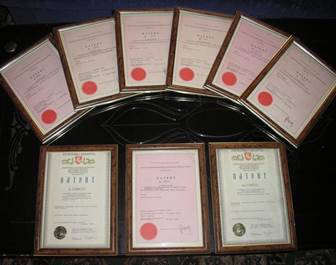
Simultaneously with the unhurried modifications of weapons had to do paperwork.
In the picture, of course, not my patents, I have much more of them, and I do not keep them in frames.
Having a wealth of experience in patenting inventions and working in a team with an experienced, reliable patent specialist, it was not difficult to fill out an application.
Three applications for filing were filed at once. Applications turned out to be principled, not for a specific device, but for a method; such applications are much harder to substantiate and they are reviewed for at least a year. Applications cover all aspects of the aerodynamic method of dispersing a bullet aerodynamically, they are:
- way to accelerate the missile
- a method of imparting rotational motion to the missile projectile
- a method of reducing friction throwing projectile in the barrel
Due to the specifics of Russia, patents are certain symbols of professional pride and nothing more. There is no material benefit from them, if there is a benefit, it is purely moral, and I have complete skepticism about these three applications, they are said to be “impassable”.
The fact is that applications in the section of the patent heading "weapons" for obvious reasons, are subject to mandatory examination. Who and how it makes me perfectly aware, I don’t have any illusions about them, most likely, all three applications will be rejected with a wording like: “technically untenable decision”.
And now about the main thing, I don’t consider myself the author of these inventions, the maximum I can claim is the title of reenactor. There are good reasons to believe that weapons on similar principles have already been created and used in the distant 1959 on the Dyatlov Pass. It was the bullets implementing the principle of aerodynamic acceleration that killed nine tourists. Other reasons for their mysterious death can not be explained.
But enough of the lyrics, here's a video of a comparative shooting
All the most important things happen in the Russian kitchen, so I had to do the shooting in the same place. The actor, director and cameraman is zero, but ... "do not shoot the pianist, he plays as he can." The main thing is still visible there. And yet, there was accidentally music in the video, this is “Karunesh”, I have nothing to do with Muslims, I just like his music.
Video filmed from one perspective, one unmounted roller. He shot what is called an emphasis in order to fit the whole process into the frame from loading to hitting the target. At a distance of a meter from the target, it is only realistic to compare the power (energy) of the shot at the muzzle. So let's compare the energy of an ordinary piston bullet and a sailing bullet.
I think the conclusion from what I saw is obvious, the holes from the sailing bullet in steel 0.8mm thick surprised even me, especially in comparison with the frivolous dents from standard steel balls.
Now specifically on the topic.
About the obvious
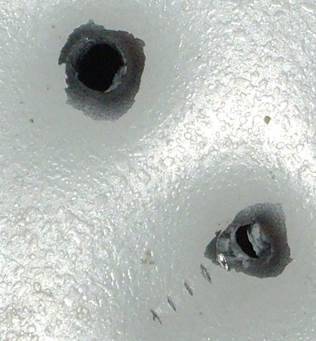
Here are two holes for sailing bullets, the first through, from a bullet with five cuts.
The second, torn hole with traces of overturning, from an elongated bullet (seven cuts), she tumbled into a collision.
The effect of overturning and yawing of a rotating bullet is caused by precession, which occurs due to the imbalance of the center of mass relative to the axis of rotation.
So the main problem for the sailing bullet is balancing.
Production of sailing bullets will not be cheap, they must be made on high-precision equipment and pass the control of balancing. To use such bullets will be expensive. But this is about the negative, now about the positive.
Three completely new physical principles of operation for artillery were involved in the sailing pool, the sum of their positive effect and led to such impressive results. The physical mechanisms used are described in the respective patent applications.
The first of these is a method of aerodynamic acceleration, when an additional kinetic energy is communicated to the throwing projectile by transferring the energy of the outgoing gas layer moving in the bore through sailing surfaces on the body of the projectile.
Secondly, this is a method of imparting rotational motion to a missile projectile when a radial component of pressure on sailing surfaces installed at an angle to the vector of gas flow in the bore is used to tighten the bullet (in other words, the principle of “oblique sail”).
The third principle is to reduce friction of the missile projectile against the walls of the barrel when gaps for free flow of the gas stream between the walls of the barrel and the throwing projectile are created, eliminating physical contact between the walls of the barrel and the throwing projectile (using the principle of gas suspension).
Now about the non-obvious
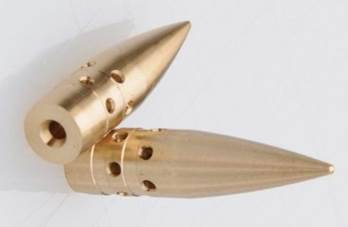
This is a snapshot of the classic “holey bullet” made using partial gas suspension technology.
Also not a cheap product by the way.
Product, piece and the price is not small ...
If the first two physical mechanisms involved in the sailing pool are fairly obvious and have obvious analogies from other areas of technology (sailing engines and wind generators for example), then the principle of gas suspension is little known. This is what is called exotic.
The main problem with the use of the gas suspension principle is the stabilization of the projectile motion, excluding the possibility of its contact with the walls of the barrel and yaw.
In classical piston systems, the barrel-projectile dilemma was that in order to stabilize the projectile it was necessary to twist it around the axis of movement, and in order to tighten it, it was necessary to ensure contact with the barrel walls to interact with the rifling. It turned out a vicious circle.
In the case of aerodynamic acceleration of the sailing bullet, the spin of the missile projectile around the axis of motion occurs without the participation of rifling in the barrel and does not require contact with the walls of the barrel.
But this is only the first part of the problem, the second part is due to the fact that the barrel in the process of firing can also fluctuate and it is necessary to compensate for these fluctuations. Here everything is much more complicated and one cannot do without the use of the principle of an aerodynamic pillow.
The essence of this physical effect (it is also called “screen”) is that when the flow channel of the moving gas layer narrows, a pressure jump occurs that is perpendicular to the axis of the flow of the gas layer.
And in our case, the ends of the sailing surfaces will play the role of such “narrowers” of the outflow of the gas layer on which high pressure zones will be created centering the projectile on the axis of the bore.
Thus, the sailing surfaces of the bullet work not only with their main planes, they also work with their ends, ensuring the stabilization of the bullet in the barrel channel relative to its central axis.
That's how difficult it is with this simple at first glance trimming screws, but the only way to implement the principle of gas suspension in practice.
And what's next?
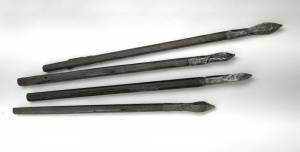
As always, you need to start with the name, because “as you call a bullet, it will fly like that.”
Everything new is a well-forgotten old, so the name BOLT immediately comes to mind.
This is the name of the crossbow arrow (in the photo), the threaded fasteners, and in all fantasy, this is the bullet of the weapon of the future.
So while this article was being written, the first of the necessary has already been done, the name was invented, as it seems to be a very apt name, “Bolt”, sounds short and meaningful, maybe it will take root ...
And most importantly, it recalls continuity. An old crossbow missile, a short metal arrow with plumage on the sides, is ideally a sailing bullet. The modern bolt with its carving also resembles a sailing bullet. And the “bolt-bullets” from the future have the same fantastic properties as sailing bullets.
Well, this is a joke, seriously, while the plans are modest, you need to make a normal sailing bullet. The current bullets from the trimming screws is a pitiful semblance of what needs to be done. Most importantly, the sailing bullet must be balanced along the axis of rotation. For this, rifling should be done in pairs and opposition. In addition, you need to perform the edges of the rifling in a special aerodynamic profile to enhance the effect of centering on the axis of the bore and significantly lengthen the bullet itself.
Only after that it makes sense to check the "purity" of such bullets. Of course, in theory, everything should be just fine, but in practice it may not be so rosy, it’s not just a matter of a pool, it’s a rifle that shoots.
Obviously, the available rifles are not very suitable for shooting such “bolt-bullets”; substantial improvement is required. It is necessary for firing "bolts" to make the corresponding small arms - "BOLTER".
So for a special gun for shooting sailing bullets immediately found a capacious name. Moreover, it turns out as in the song; "..We were born to make a fairy tale come true ...". After all, "Bolter" is a weapon from the future, appearing in all combat fantasy.
It's a joke again .. But seriously, firstly, you need to increase the pressure in the barrel, for pneumatics, the optimum pressure will be 250 atmospheres, with this pressure you can provide bullet energy in the 100-150 joule, and effective lesion distance in 300- 500 meters. It will already be a full-fledged military weapon, not a toy.
Secondly, the barrel should become smooth, the rifle with a smooth barrel sounds today as absurd, but apparently it will soon become commonplace.
Thirdly, it is necessary, if not strange, to reduce the caliber of the barrel. And while the bullet itself is lengthened, it should essentially turn into an arrow. The optimum gauge for pneumatics will be about 3 millimeters in diameter, and the bullet length about 30 millimeters.
And one more completely not obvious step contradicting the traditional principles of design of rifle systems - the barrel length of a rifle should be reduced.
The fact is that the force of the shot directly depends on the speed of the outflow of the gas jet, and it in turn depends on the length of the barrel, the shorter the barrel, the higher the rate of outflow of gas. On the other hand, other laws work for a sailing bullet than for an ordinary piston bullet; it accelerates much faster, because the gas pressure is transmitted not only to the bottom of the bullet, but also to its lateral sailing surfaces. Therefore, it is possible to provide the required acceleration at much shorter barrel lengths.
If we talk about pneumatics, aerodynamic bullets for the powder systems open up quite ambitious prospects, but I’m not going to do this later, purely theoretically. I will deal with a fundamentally new type of rifle systems, intermediate between pneumatics (gas) and powder (solid-state) systems, and, as is known, there is also a liquid one between gas and solid state.
That it represents the greatest interest for aerodynamic acceleration.
Information